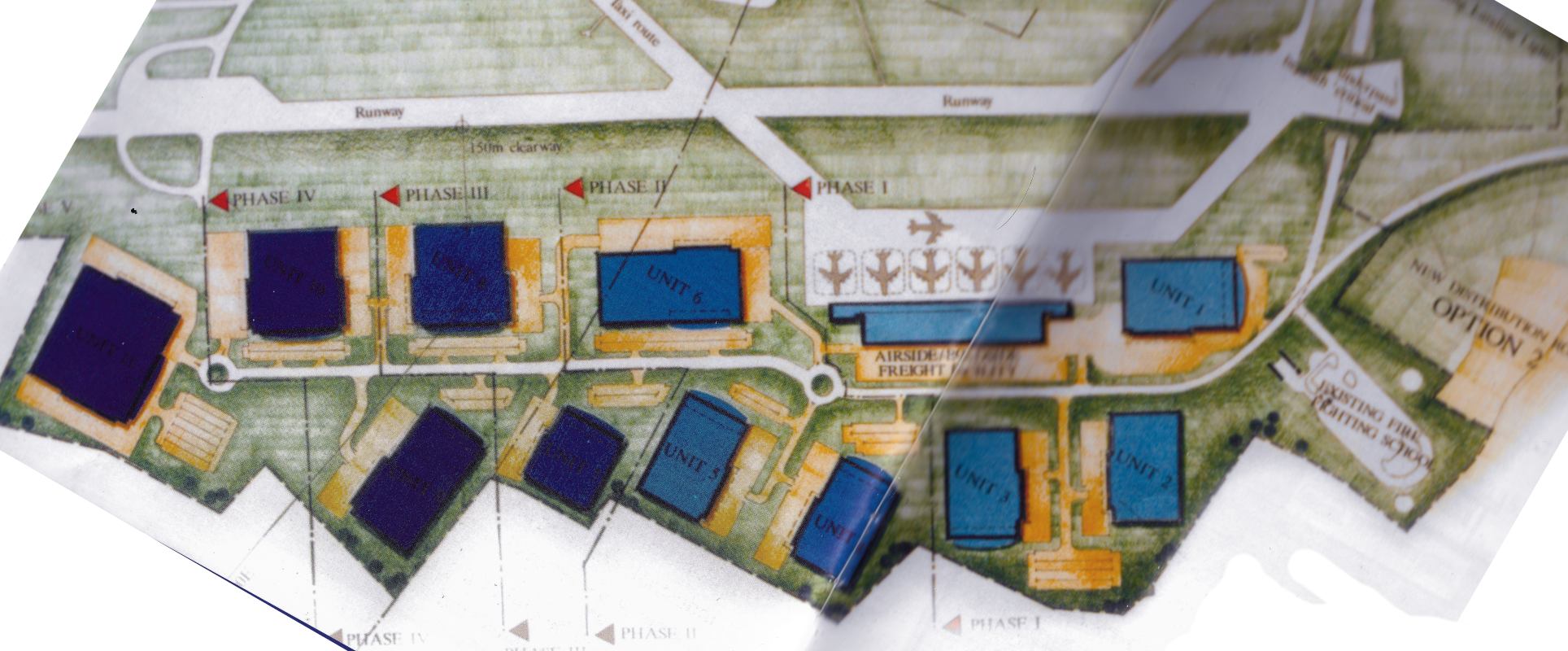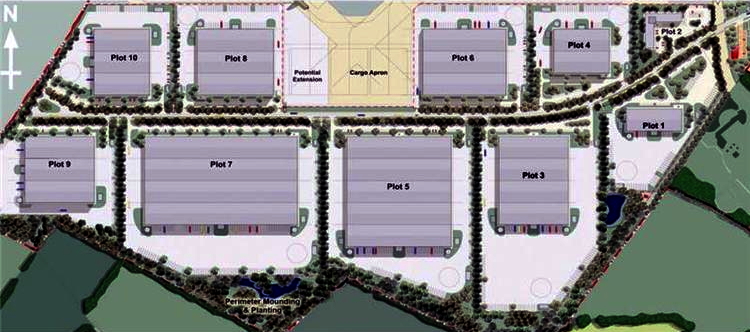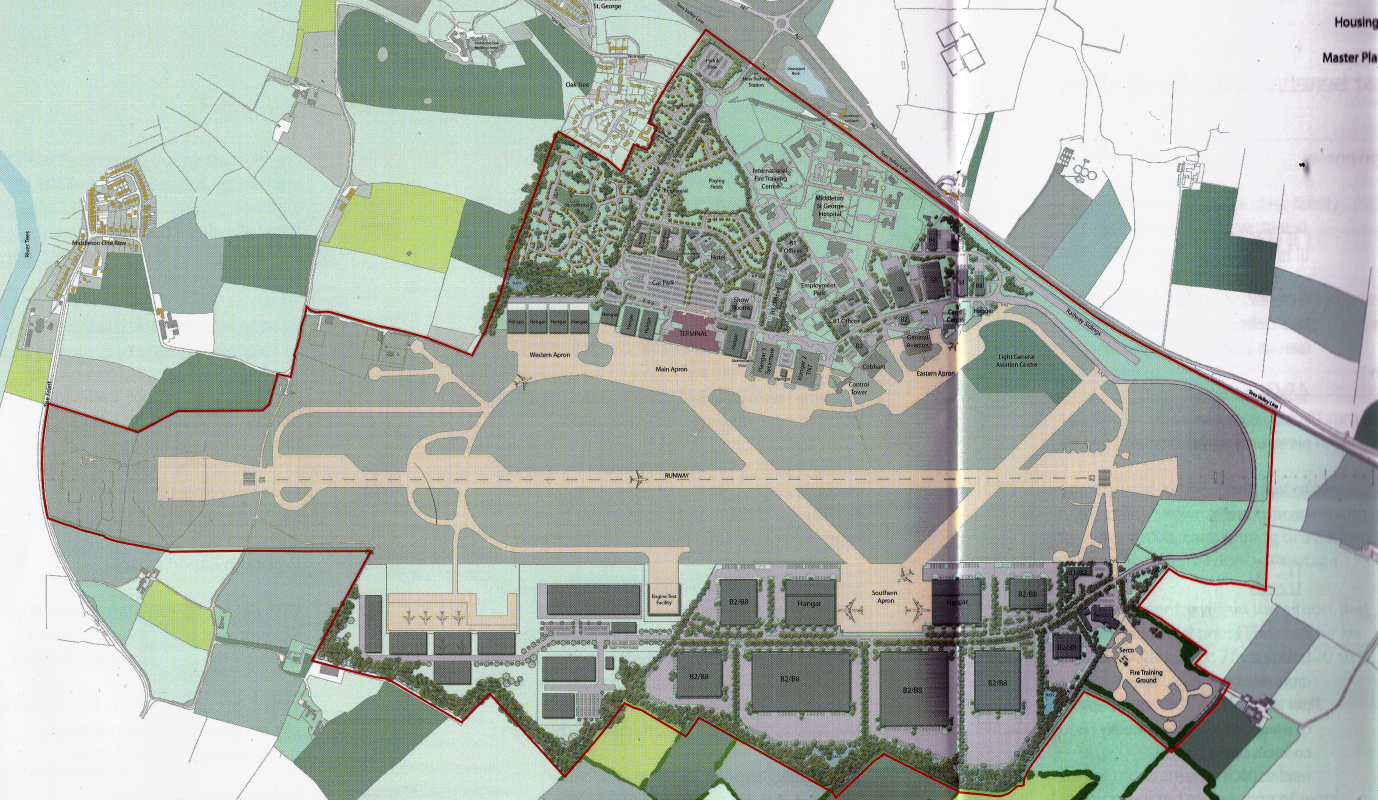Southside
The Journey So Far
| By Chris Smith | |||||||||
| We have recently been presented with the latest attempt at a southside development - the fourth during my time following the airport but the first by the current owners. As such I thought now might be an appropriate time to look back and compare the previous efforts. | |||||||||
| "The
Future Southside Development" Developer: Moorfield Group Dates: c.1995-2003 Reason for failure: Deemed unrealistic and not financially viable. |
|||||||||
| Size: | 250 acres | Cost: | £4m+ | Jobs: | 5,000 | Aviation: | Yes | Planning approval: | Yes |
| This is the first proposed development
that I am old enough to recall - I don't believe it was
considered necessary to unlock land value at airports
prior to this. Looking at the drawings I've found, the
whole concept was heavily aviation related (as it should
be) and revolved around cargo and freight. In the image
below, you can see a five-phase plan featuring a cargo
terminal approximately double the size of our existing
passenger terminal plus six aircraft stands, supported
by 11 warehouse units, the smallest of which could just
about encompass hangars 1 and 2 combined! There are also
rail freight sidings (just right of the image below) and references to "Option 1" and
"Option 2", which appear to relate to a choice of two
access roads, the first would be an immediate left off
the current entrance roundabout, skirting around the existing northside
business park where the hospital is, running parallel to
the alpha taxiway before disappearing under an underpass
beneath the 23 threshold. The second is the far more
common attempt at a separate access leading off the A67.
The cost listed above is around £8.1m at 2021 value and
is believed to have covered mainly the surface access. Links: (1) (2)  |
|||||||||
|
"Skylink International Business Park" Developer: Peel Holdings / Tees Valley Regeneration Dates: 2008 - 2013 Reason for failure: Recession, RGF rejection, possible lack of forthcoming tennants |
|||||||||
| Size: | 250 acres | Cost: | £110m | Jobs: | 3,500 | Aviation: | Yes | Planning approval: | Yes |
| Received with skeptisim and
sarcastically referred to as "Plan H" by many, this was
on reflection very similar to the nineties effort, with
a two-stand apron (with the possibility of adding an
additional stand in future) and 10 warehouse units.
Readers may remember the airport applied twice to the
Regional Growth Fund to kick start this project, first
asking for £5.9m in 2012, followed by a second attempt
in 2013 for £4.65m, both of which were rejected. It is
believed this was for utilities and the access road,
which would have been the "Option 2" from the original
development connected to the A67. If memory serves, any
successful RGF applicant would have to invest a further
80% on top of what was granted via the RGF. The
controversial housing development was conceived as an
alternative means of raising the money instead. It was
also intended for the site to be designated an
"Enterprise Zone", which I believe is essentially tax
concessions and a poor mans version of the Freeport
concept we have now. During my research for this
article, I noticed more than one property agent are
still advertising plots for this project! Links: (1) (2)  |
|||||||||
| "Aero
Centre Tees Valley" Developer: Peel Group Dates: 2013 - 2019 Reason for failure: Airport takeover |
|||||||||
| Size: | 250 acres | Cost: | £280m | Jobs: | 4,000 | Aviation: | Yes | Planning approval: | Not submitted |
| The southside development born out of
the 2013 "Master Plan to 2020 and Beyond" and falling
under the Aero Centre Tees Valley concept from 2015
onwards, was identical to the Skylink International
Business Park except for the apron included all three
stands right from the off, and there were provisions to
relocate Serco next to their burning ground. There was
also a whole new section to the west of the inherited
development, which included a second apron with four
stands and a hangar with capacity for two aircraft, a
further eight industrial buildings on top of the
existing 10, and an engine test bay. Access would have
been from a controversial road extending from near the
current rail halt, necessitating the relocation of the
alpha taxiway just beyond stand 13, and requiring a
railway-crossing style traffic light system at the
runway 23 threshold. This development encompassed the
whole estate, we've left the size above at the 250 acres
that make up the southside, but the cost and jobs
probably related to the full site. Developments on the
northside included the planned housing estate, nine
further hangars of which four were attached to a new
apron west of the existing main apron, an "Employment
Park" made up of around eight warehouse units, numerous
offices, a cargo centre and railway sidings, and a new
railway station under the bridge on the current access
road. Links: (1) - pages 12-15  |
|||||||||
|
Untitled Teesside Airport business park Developer: Tees Valley Combined Authority Dates: 2022 - present |
|||||||||
| Size: | 250 acres | Cost: | £200m | Jobs: | 4,400 | Aviation: | Yes | Planning approval: | Not yet submitted |
| Almost identical to the previous
projects, with the same aircraft apron and very similar
warehouse capacity. The airport
require Serco to move their burning ground,
this Northern Echo article goes into more detail
regarding the negotiations. The plans do not appear to
encroach onto the IFTC site, and
it is thought the issue relates to smoke blowing over
the units and associated smoke damage, odd given that
not only has this not been an issue in the previous projects,
but one even included office space and accommodation for Serco to be
next to their facility. The southside business park will form part
of the Teesside Freeport. Links: (1) (2)  |
|||||||||
| To conclude, I wasn't expecting them to be so similar to each other! We were indifferent towards the housing development because it was on land too far removed from the airport infrastructure to be used for anything relating to aviation, that's not the case here and as such aviation must feature, and whilst that one apron is enough to suffice for now, we hope there is still scope for further southside aviation expansion in future. | |||||||||
